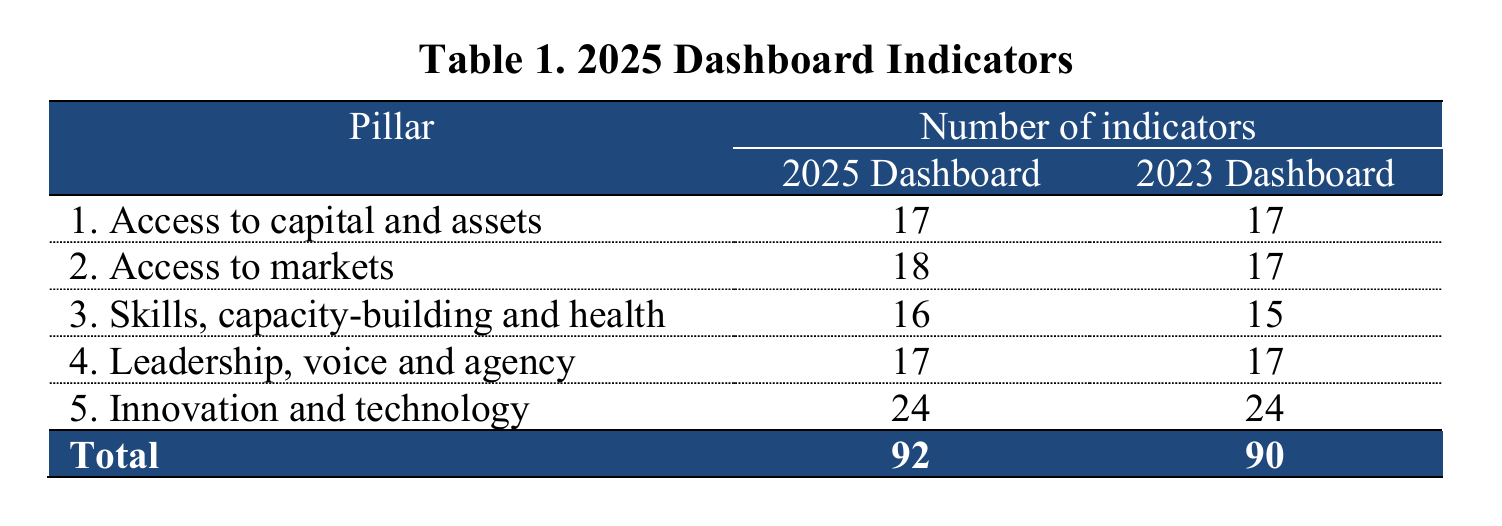EXECUTIVE SUMMARY
KEY FINDINGS: Uneven progress and persistent gaps demand urgent action
It has been 10 years since the APEC Women and the Economy Dashboard was first launched in 2015. Monitoring movements in indicators in the last 15 years shows considerable progress in some aspects of women’s participation in economic activity. However, most indicators have either been stagnant or shown incremental changes. Gender inequality across APEC economies remains deep, persistent, and systemic. Legal reforms, targeted policies, and sustained political will are crucial to dismantling barriers and ensuring women’s full, equal, and meaningful participation and leadership in all facets of the economy.
• Progress on gender equality has been uneven across APEC. While access to finance and technology has improved for women, with notable gains in financial inclusion and digital access, persistent gaps remain in economic participation, leadership, safety, and legal protection.
• Women’s access to financial services has improved, with formal account ownership increasing to 82 percent in 2021 from 59 percent a decade ago. However, fewer than half of APEC economies have laws prohibiting sex-based discrimination in credit access.
• Wage inequality remains entrenched, with women earning only 70 percent of what men earn on average. Progress since 2008, the base year when the Dashboard began tracking indicators, has been slow and inconsistent.
• Women face ongoing legal and structural barriers to employment, including restrictions on working in certain industries, lack of legal protections against workplace discrimination, and unequal pay legislation in most economies.
• Unpaid care and domestic responsibilities continue to fall disproportionately on women, limiting their opportunities for paid work, education, and entrepreneurship.
• Female labor force participation remains below 60 percent, with only a weak recovery following a significant drop during the COVID-19 pandemic.
• Women remain underrepresented in leadership roles, holding only around 28 percent of parliamentary seats and 22 percent of ministerial positions across APEC economies. Private sector leadership by women has also remained low, although data in this area has been incomplete for many years.
• Despite near gender equality in general education, women’s participation in technical and vocational training has declined, limiting access to higher-paying, male-dominated industries that often require specialized skills and certifications, reinforcing occupational seggregation and wage gaps between women and men.
• Digital inclusion has improved, with women comprising 78 percent of internet users. However, their participation in STEM fields remains low at an estimated average of below 30 percent across APEC economies, while data on women engagement in R&D is sparse and inconsistent.
• Legal frameworks to protect women against violence and harassment have expanded, but data coverage, enforcement of these laws, and limiting social norms remain persistent issues across the region.
SCOPE OF THE DASHBOARD
Background
The APEC Women and the Economy Dashboard offers a snapshot of the status of women in the region by tracking key indicators over time. It aims to measure progress, uncover data and policy gaps as well as spotlight social barriers that continue to hinder women’s full, equal and meaningful participation and leadership in the economy. First launched in 2015, the Dashboard is updated biennially to track women’s status in APEC, with indicators revised based on data availability and relevance.
The Dashboard indicators, endorsed by the APEC Policy Partnership on Women and the Economy (PPWE), were selected based on the five priority pillars identified by the PPWE: 1) access to capital and assets; 2) access to markets; 3) skills, capacity-building and health; 4) leadership, voice and agency; and 5) innovation and technology.
International organizations are the main data sources, including the International Labor Organization (ILO), the International Telecommunication Union (ITU), the Inter-Parliamentary Union (IPU), the Organisation for Economic Co-operation and Development (OECD), the United Nations (UN), the World Bank (WB), the World Economic Forum (WEF), and the World Health Organization (WHO), among others.
The Dashboard is designed to support the integration of women’s perspectives across APEC’s work. With its cross-cutting indicators spanning various dimensions of women’s economic participation, the Dashboard serves as a practical tool for APEC technical working groups and sub-fora to identify opportunities, projects, and policy areas that could meaningfully promote women’s empowerment.
Updates to the 2025 Dashboard
At the beginning of the publication year, the APEC Policy Support Unit (PSU) conducts an inventory of the Dashboard indicators to ensure that they remain up-to-date and relevant. Indicators whose data series have been discontinued or not updated by the main data sources for at least five years are proposed to be removed and/or replaced by new, usually similar indicators. Moreover, adding new indicators with sex-disaggregated data is also proposed to strengthen certain priority pillars. For example, to track women’s health, the indicators on women’s mortality rate from non-communicable diseases (NCD) and the prevalence of diabetes among adult females were added.
The other new indicators cover the state of infrastructure, competitive market access for entrepreneurs, and contributing family workers under Pillar 2 to understand disparities in these areas and their impact on women’s economic participation; as well as female participation rate in technical and vocational programs under Pillar 3 to determine women’s involvement and inclusion in skills-building initiatives.
The 2025 Dashboard comprises 92 indicators spanning 2008–2024 (Table 1), with most data updated through 2021–2023. However, persistent data gaps—particularly on women’s unpaid work, female graduates in Science, Technology, Engineering, and Mathematics (STEM), women researchers and those in research and development (R&D), and the share of firms with female owners and managers—hinder a comprehensive understanding of women’s economic participation. These limitations obscure critical insights into women’s contributions across sectors and their representation in private sector leadership, undermining efforts to inform evidence-based policies.

This report contains 22 dashboards, one for each of the 21 APEC member economies and another for the APEC region as a whole. This Executive Summary focuses on the main results obtained by APEC as a region. In some cases, APEC aggregates were not calculated due to the lack of data in several APEC members.
Click to read more